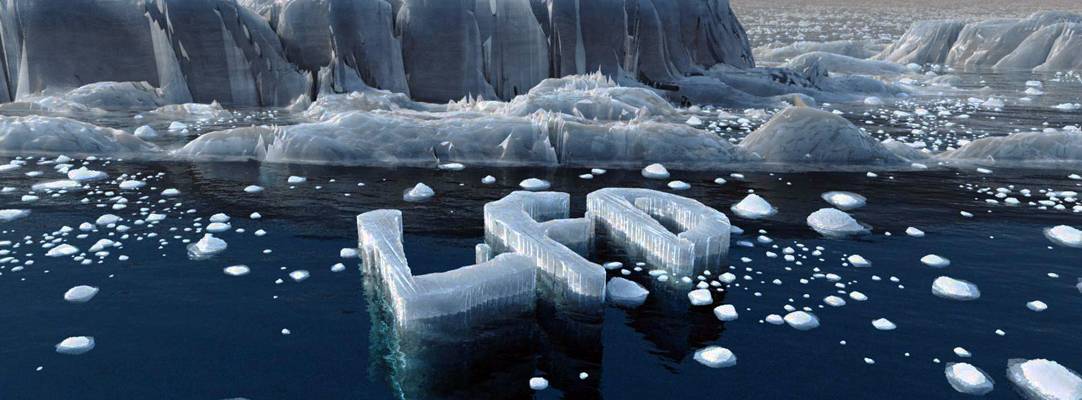The Climactic Effects of Earth’s Orbital Cycles
There are three orbital features that combine to shape the Earth’s natural climate cycles, known as the Milankovitch cycles.
Page Contents
The Orbital Cycles
As well as the annual summer-winter climate changes we can experience, there are three long-duration cycles that combine to shape the Earth’s natural climate that extend over thousands of years. These are known as the Milankovitch cycles.
They consist of:
- Earth’s changing axial tilt relative to the orbital plane (obliquity): 41k years
- The changing direction of Earth’s tilt over time (precession): 26k years
- The changing shape of its Earth’s orbit (eccentricity): 95k years.
The cycles will alter over time as the moon moves away from the Earth.
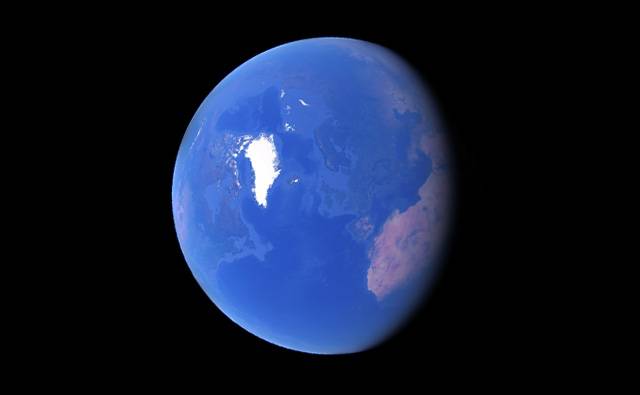
Earth’s Axial Basics
To understand the long-term climate effects, it might help to understand the daily and annual effects of Earth’s rotational axis.
What is an Orbital Plane?
The directions and angles used in this article will often be made with respect to Earth’s orbital plane.

Due to the way a solar system forms, all of it’s planets would normally be in the same orbital plane and orbit in the same direction. The majority of its material would be distributed as a disk.
If you were to imagine a line connecting the centre of the Earth with the centre of the Sun, the line would be on the orbital plane.
The Axial Tilt
Earth’s axis is inclined by 23.5° with respect to its orbital plane; it’s held steady by the moon and it points in the same direction throughout the year with respect to the solar system. However, the angle between the direction of the axial tilt and the direction towards the sun from earth changes continually as the Earth moves along its orbit.
To illustrate how the earth’s tilt affects the night and day cycle, here are three schematic diagrams showing London, UK at a latitude of 51.5°. The orbital plane isn’t shown but would be a horizontal line passing through the centre.
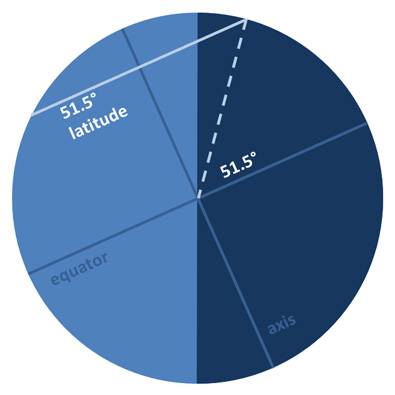


In these diagrams, ‘above’ and ‘side’ are relative to the orbit of the Earth around the sun. Fig-1 is illuminated by the sun offscreen to the left while fig-2 and fig-3 are illuminated from the right.
Annual Variation in Lighting
In winter, the sun is lower in the sky. Refer to fig-4: the latitude of London (51.5°) plus the axial tilt (23.5°) is 75° and the sun will appear 90° – 75° = 15° above the horizon at its highest point in mid-winter.
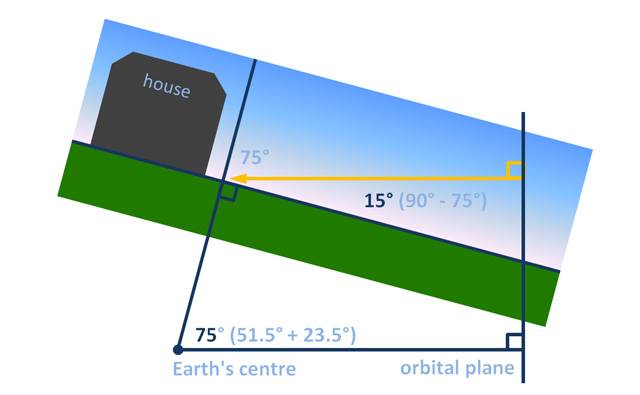
In summer, the sun is higher in the sky. Refer to fig-5: the latitude of London minus the axial tilt is 28° and the sun will appear 62° above the horizon at its highest point in mid-summer.
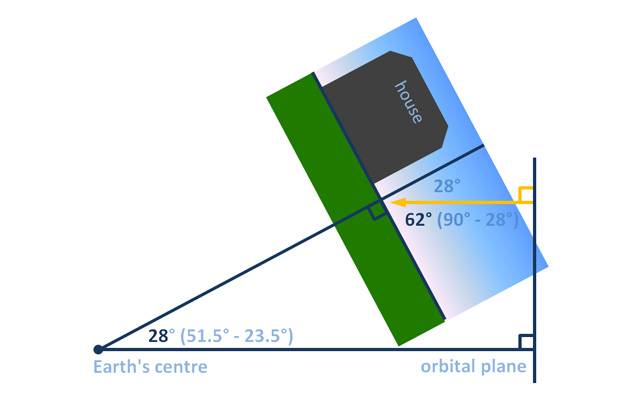
From the point of view of the London householder in fig-6, the winter sun penetrates more deeply into the house than the summer sun.

Since earth’s tilt is responsible for the summer and winter extremes, averaging those angles should lead us back to the tilt angle, and we can use this to check our figures. Take the difference of the angles of the summer and winter sun and divide by 2:
((62° – 15°) / 2) = (47° / 2) = 23.5°
Note: The calculations shown here are approximations assuming that the Earth is a perfect sphere. It’s not, the spin throws the equator outward slightly, making the actual shape an oblate spheroid. Actual measurements of the angle of the suns rays are in the range 15.1° to 61.9°.

Why is the Winter Sun Different?

Continuing to use London as the example location, the winter sun’s rays traverse 3.4 times more atmosphere than do the summer sun’s rays. If the air is filled with dust or moisture, more of the light and energy will be dispersed leaving a cooler and milkier appearance than in summer.

In addition, when the winter sun reaches level ground, the illuminated area is 3.4 times larger, therefore cooler and dimmer.
Long-Term Variations in Climate
Milutin Milankovitch
Milankovitch was a Serbian scientist who contributed the reasoning for Earth’s long-term climate variations. He founded planetary climatology.
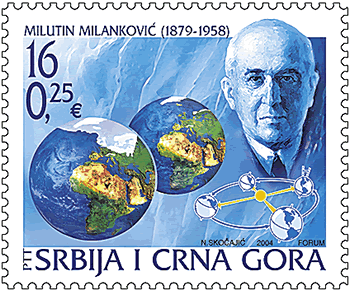
The Changing Axial Tilt (Obliquity)
Over a long period of time, the axial tilt slowly wobbles by ±1.2°. At the Earths surface, the latitudes would rotate north and south relative to the orbital plane by approximately ±133 kilometres (±83 miles).

- The tilt ranges between 22.1 to 24.5 degrees
- The tilt cycles through the range every 41,000 years
- We are currently at 23.5 degrees, near the middle of the range
The axial tilt affects the average temperature of the Earth, the temperature contrast between the seasons and the amount of sunlight that reaches the poles.
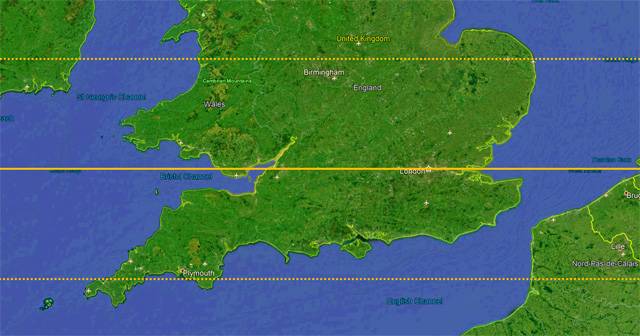
The Direction of the Axial Tilt (Precession)
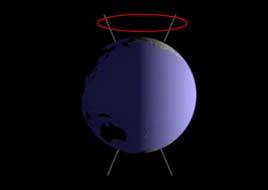
While the axial tilt remains stable over hundreds of years, it is not static. The direction of the tilt performs a full circle every 26,000 years. This means that what we consider to be the north star will change over time.
The wobble is caused by the torque of the other planets in our solar system on Earth’s equatorial bulge. The precession changes the timing of the seasons in Earth’s orbit.
- The axial precession completes one cycle in 26,000 years.
- Currently, the Earth has perihelion very close to the winter solstice.
The Changing Orbital Shape (Eccentricity)
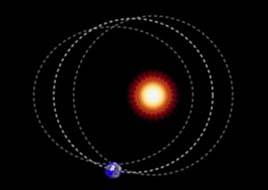
Earth’s orbit around the sun is nearly, but not quite circular. It’s a slightly elliptical orbit that varies in shape cyclically over a 90,000 – 100,000 year period. The variation is due to the gravitational attraction of neighbouring planets, particularly Jupiter and Saturn.
Earth’s closest approach (perihelion) and furthest departure (aphelion) from the sun varies by 3%, and this accounts for a 20-30% difference in solar radiation received.
Earth’s orbit undergoes precession, which moves the positions of aphelion (furthest point) and perihelion (nearest point) within the orbit.
- Earth’s orbit is a nearly circular ellipse.
- The distance of Earth from to the Sun varies by 3%.
- The shape of the orbit varies over a 90,000 to 100,000-year cycle.
- At present, the orbital eccentricity is nearly at the minimum of its cycle.
The Not So Obvious Result is an Ice Age
The changing position of summer and winter along Earths orbit due to axial precession will inevitably match extremes of axial tilt and orbital eccentricity at some time
An Animation of Milankovitch cycles
Run Time: 1 minute
An excellent animation by Tobias Friedrich showing all three Milankovitch cycles on one page. Screenshots from this animation have been used to illustrate parts of this article.
An Explanation of the Milankovitch Cycle
Run TIme: 5:41
A clear video by William Stafford narrating animations that explain the cycles.
Climate Change
Whilst the Milanchovic Cycles do change Earth’s climate over long time cycles, the effect that humans have had recently are measurable. All of the extreme weather effects that we have seen are due to the increased concentration of Carbon Dioxide in the atmosphere.
CO2 traps energy in the atmosphere that would normally be radiated back out into space. This energy is then distributed into the weather systems, raising the overall temperature and making weather events more extreme.
Historical CO2 Levels
You can see from the NASA chart that for the past 800,000 years that the CO2 concentration has been cycling between 160 to 300 parts per million and stayed fairly level during that time. Since 1950, the concentration has increased by about one-third.
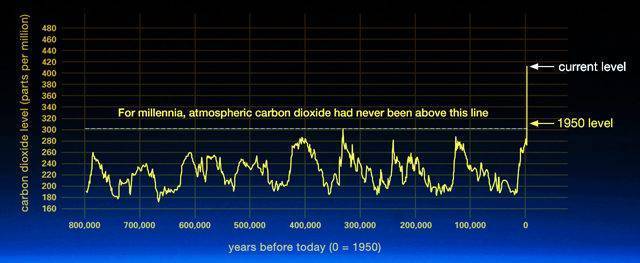
CO2 Proportion
The amount of CO2 currently in the atmosphere represents a small percentage of the total, about 0.04%. Unfortunately, this makes it a lot easier to upset the balance. The fractional change to the atmosphere that has occurred in recent times is already exaggerating the extremes of weather across the globe.
Choosing a Way Forward
Here are some of the current solutions to counter climate change. None of them will work without population control.
Green Energy Options
- Capture CO2 using tech
- Global reforestation
- Preferential use of solar, hydro, wind and tidal energy sources
The options to reduce atmospheric CO2 don’t fit comfortably with the reasons we have this problem in the first place. All of the alternate energy sources costs money, obstructs exploitation and can only be truly effective with a united global effort.
Nuclear Fission
The toxic nature of Nuclear fission power stations should require a perfect operational state in order for them to be used. This is not possible in the real world. Waste materials remain hazardous for tens of thousands of years. In the few decades that stations have been in operation, there have been significant accidents.
Nuclear Fusion
This is a much safer nuclear option that will provide abundant power if it ever becomes available at scale. With a reduced CO2 level, the heat generated by the use of this new energy source would (probably) be radiated into space quite naturally.
Population Control
This is the root issue that underpins climate-change and many related problems that no-one actually talks about. Any solution you can pick for climate change would currently be defeated by unchecked population growth (see note-1)
Given what is available at the moment, population control is necessary to achieve long term stability. Since this is an unpopular notion, the only solutions that do get any attention are those that mitigate increasing energy use, preferably solutions that don’t require individuals to do much.
Earth’s population is estimated to be 7.7 billion and is rising. The rate of growth is also rising. If the world’s population were reduced it would:
- Remove the pressure on land for agriculture
- Reduce CO2 emissions
- Reduce chemical and plastic pollution
- Help endangered species to recover
Note-1: Why Bother?
Perhaps in the future, it might be possible to use nuclear fission to provide clean energy. It might eventually be possible and then necessary to cover the entire globe with a vast population. The limits of that growth would be delayed by several 10’s of generations into the future. You might also think that it’s better to wait and see if the problem ever surfaces before you try to deal with it. From a practical point of view, maybe that point of view is correct.
I guess I have a problem with the idea of continual growth per se. It strikes me as a fundamentally selfish stance. Continual stability seems like a much smarter and more noble target to aim for and it brings with it the idea of living in harmony with the environment, rather than consuming it.
References
- climate.nasa.gov
- www.nrc.gov
- www.universetoday.com
- www.indiana.edu
- www.skepticalscience.com
- earthobservatory.nasa.gov
- study.com
- principia-scientific.org
Disclaimer
Care has been taken to keep the information in this article as accurate as possible but errors are possible, so be aware of the full disclaimer here.
